Best studio monitors under $500/£500 in 2025: High-range sound on a mid-range budget
The best affordable studio monitor speakers for those mixing on a smaller budget, from KRK, Yamaha, Presonus and more
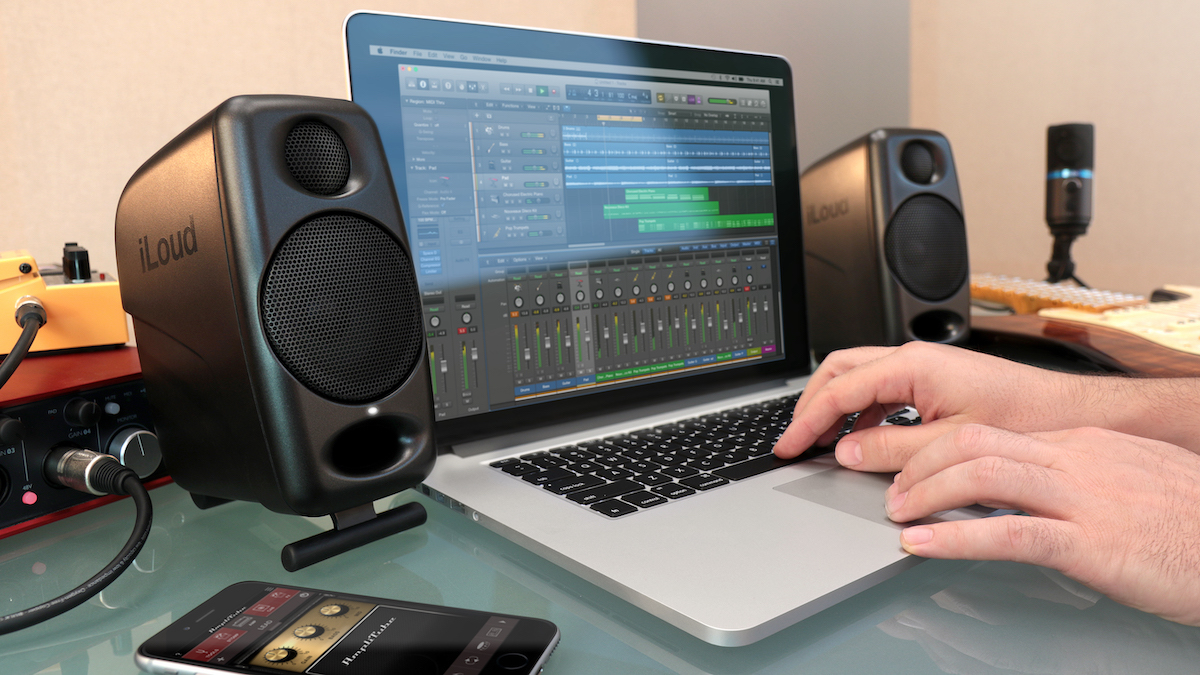
1. Quick menu
2. Best for bass heavy genres
3. Best for value
4. Best for larger studios
5. Best for small studios
6. Best sound for the money
7. Best for mega tight budgets
8. Best portable speakers
9. Best compact monitors
10. Best all-round performance
11. Buying advice
12. How we test products
As a music producer you need to hear every detail of your mix, and that's why the studio monitor is the most important purchase you might well make. Luckily, in recent years, while the quality of monitors has gone up, many prices have come down and you can now get a great set of studio speakers for a very reasonable outlay. In this guide we've rounded up the best studio monitors under $500/£500 with models from some of the biggest names in the speaker business - and all at prices that shouldn't break the bank.
Studio monitors are designed to allow you to hear the intricate detail of a music mix and they have to be 'honest' in doing so. As a producer you need to hear everything - including any mix mistakes you have made - to correct them. This means your monitors have to deliver a flat frequency response across the board, with no peaks or dips emphasising or hiding certain bands.
At one time you'd have had to pay top dollar for this kind of accuracy, but we think we've unearthed some great models in our guide to studio speakers under the $500/£500 mark that deliver the detail and honesty you need, for a sensible budget.
We've also included some detailed buying advice at the end of this guide. If you'd like to learn more about what you need when choosing a new pair of speakers, we'd recommend you head straight there.

Andy has been writing about music production and technology for 30 years having started out on Music Technology magazine back in 1992. He has edited the magazines Future Music, Keyboard Review, MusicTech and Computer Music, which he helped launch back in 1998. He has tested hundreds of pieces of music-making hardware and software over the years, including the monitors in this guide.
Best studio monitors under $500/£500: Quick list
Want to cut to the chase and find out exactly which we think are the best studio monitors under $500/£500 on the market right now? Below, you’ll find a round-up of our top choices. You can jump to a more detailed review of every pick, along with our price comparison tool to help you find the best deals.
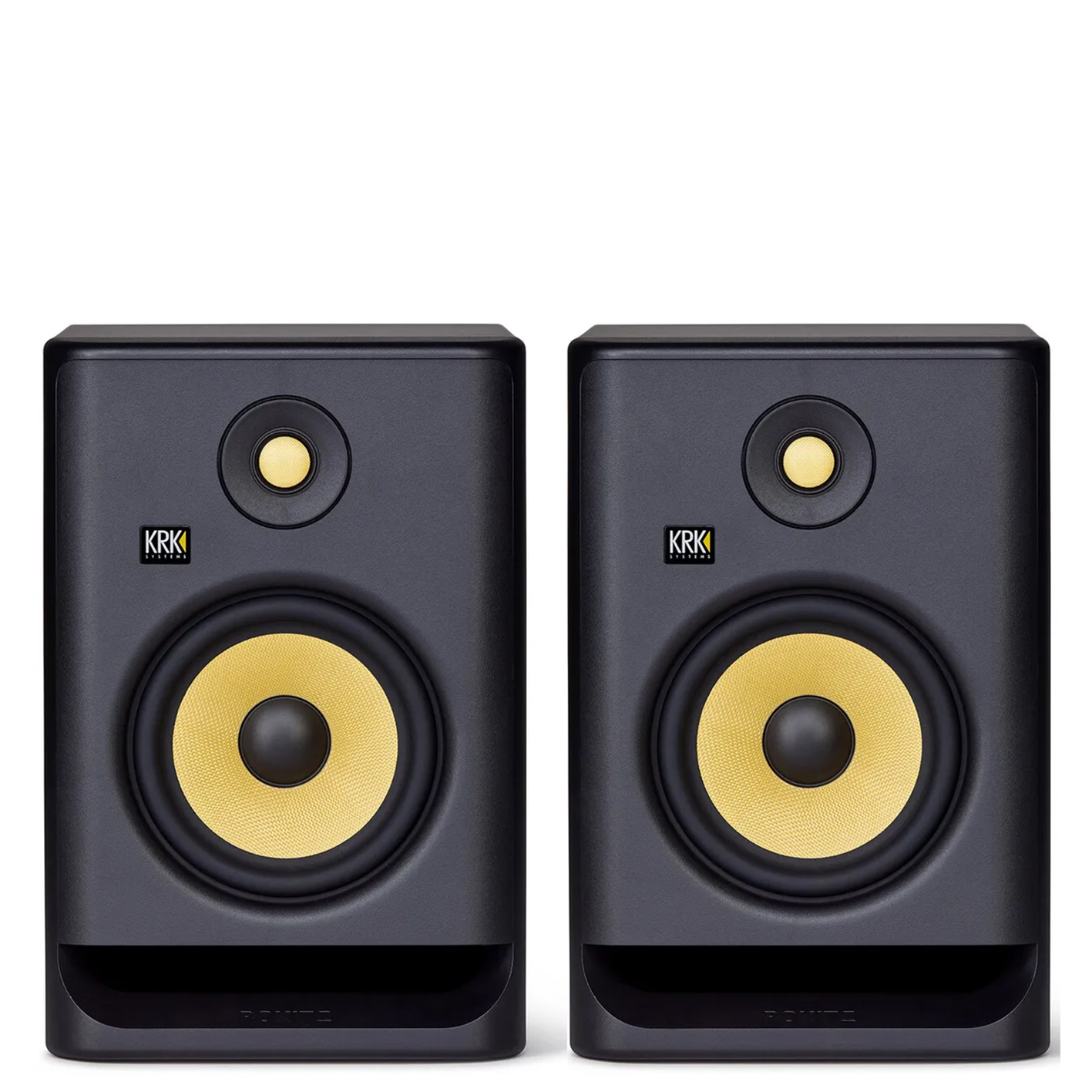
The G4 range has some rare features for this price, the most notable being its extensive graphic EQ power. There's built-in digital signal processing (DSP) which offers a suite of tools that includes a room analyser. This has become more popular among higher-end speakers and essentially ensures the speakers' sound compensates for the space you're working in.
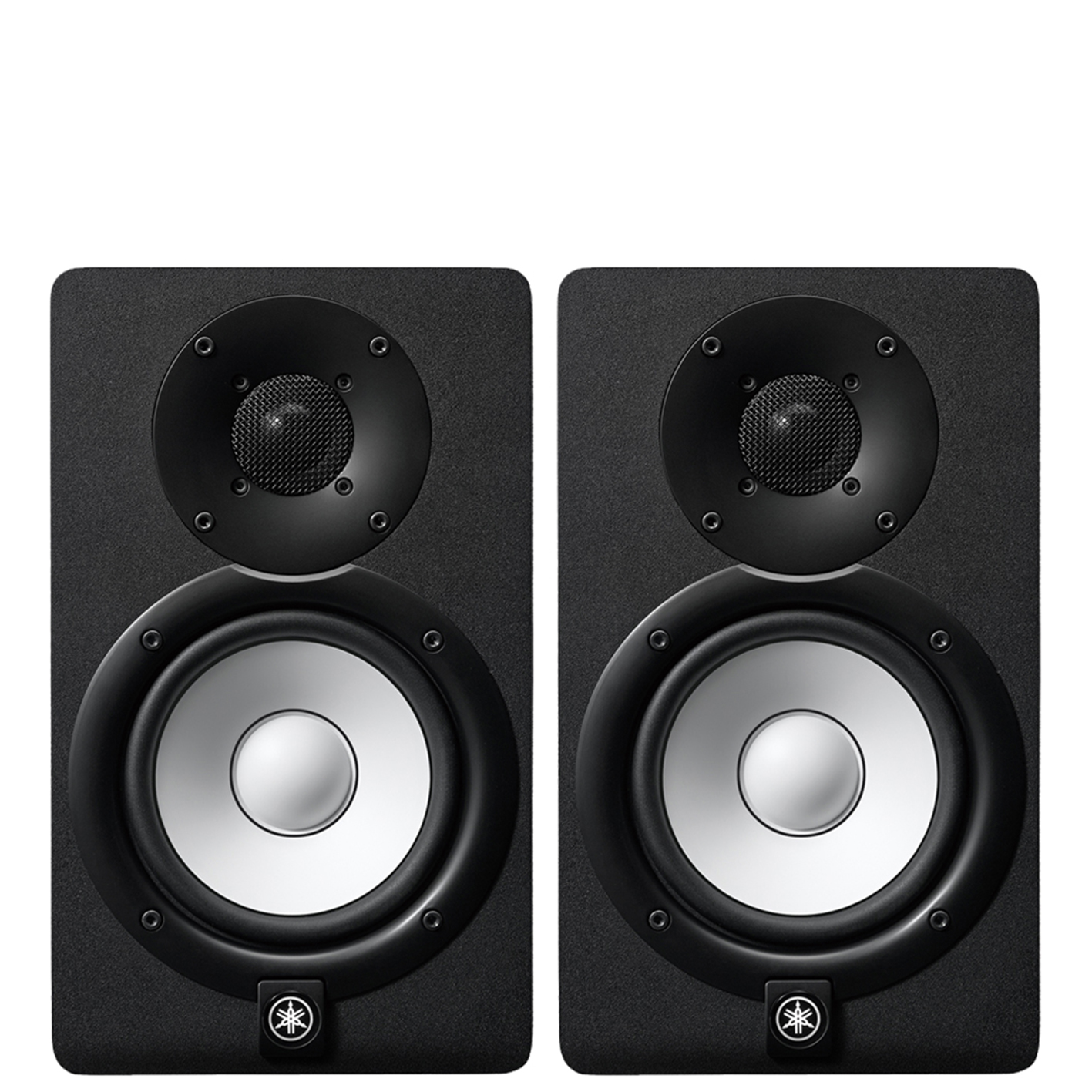
The HS5s are incredible for their price. Measuring only 6.7" x 11.25" x 8.75" and weighing around 12 pounds, the HS5 are most obviously more suited to smaller studio set-ups. That said, a 45W amplifier powers the woofer, while a 25W amp drives the tweeter, so that's enough juice to make a pair of these go loud enough in most rooms.
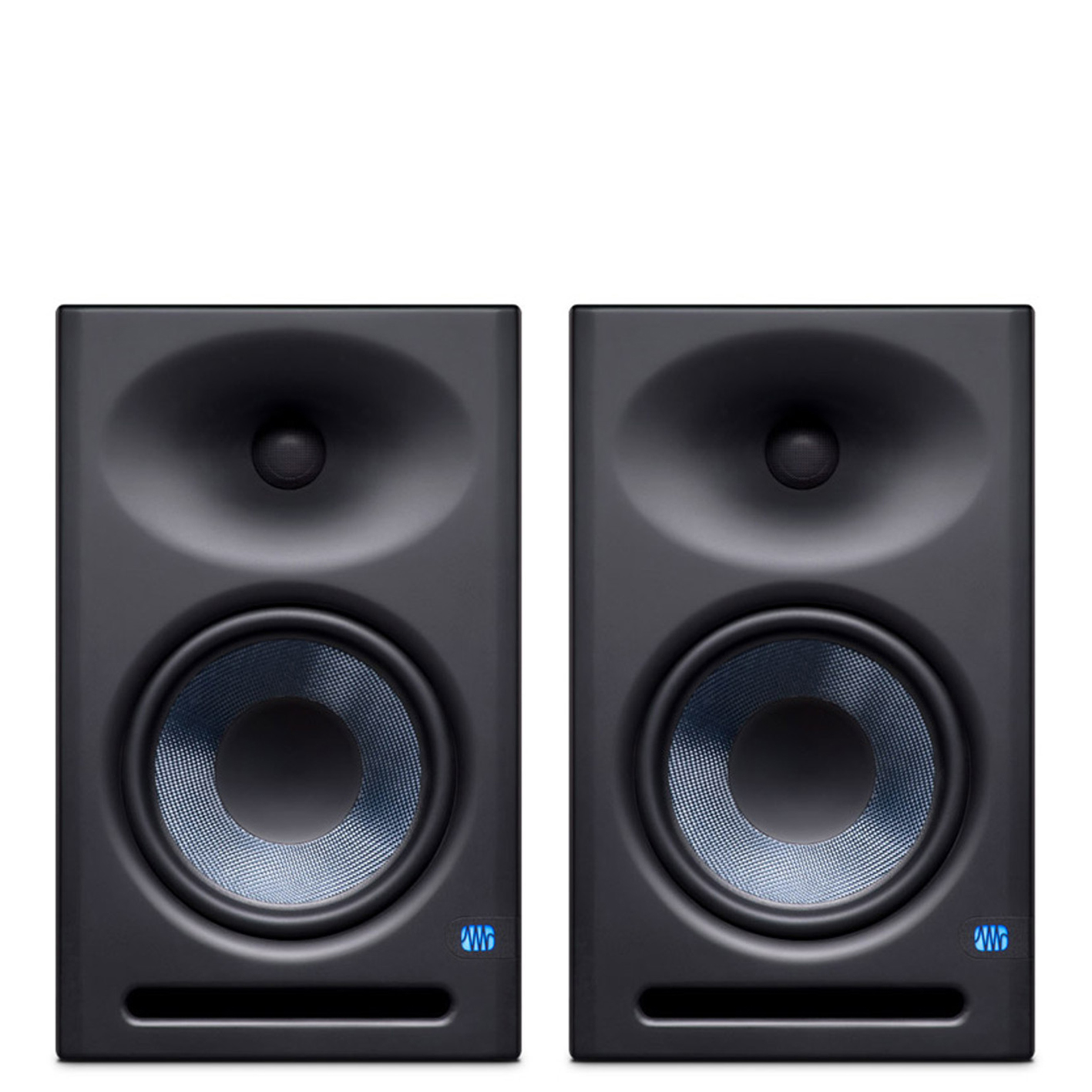
The E8XT delivers the sort of sound and volume you'd expect from slightly larger speakers. And coupled with the broad sweet spot and extended bass, they’re great for both tracking and mixing in larger spaces. Build quality is excellent and they also offer incredible value.
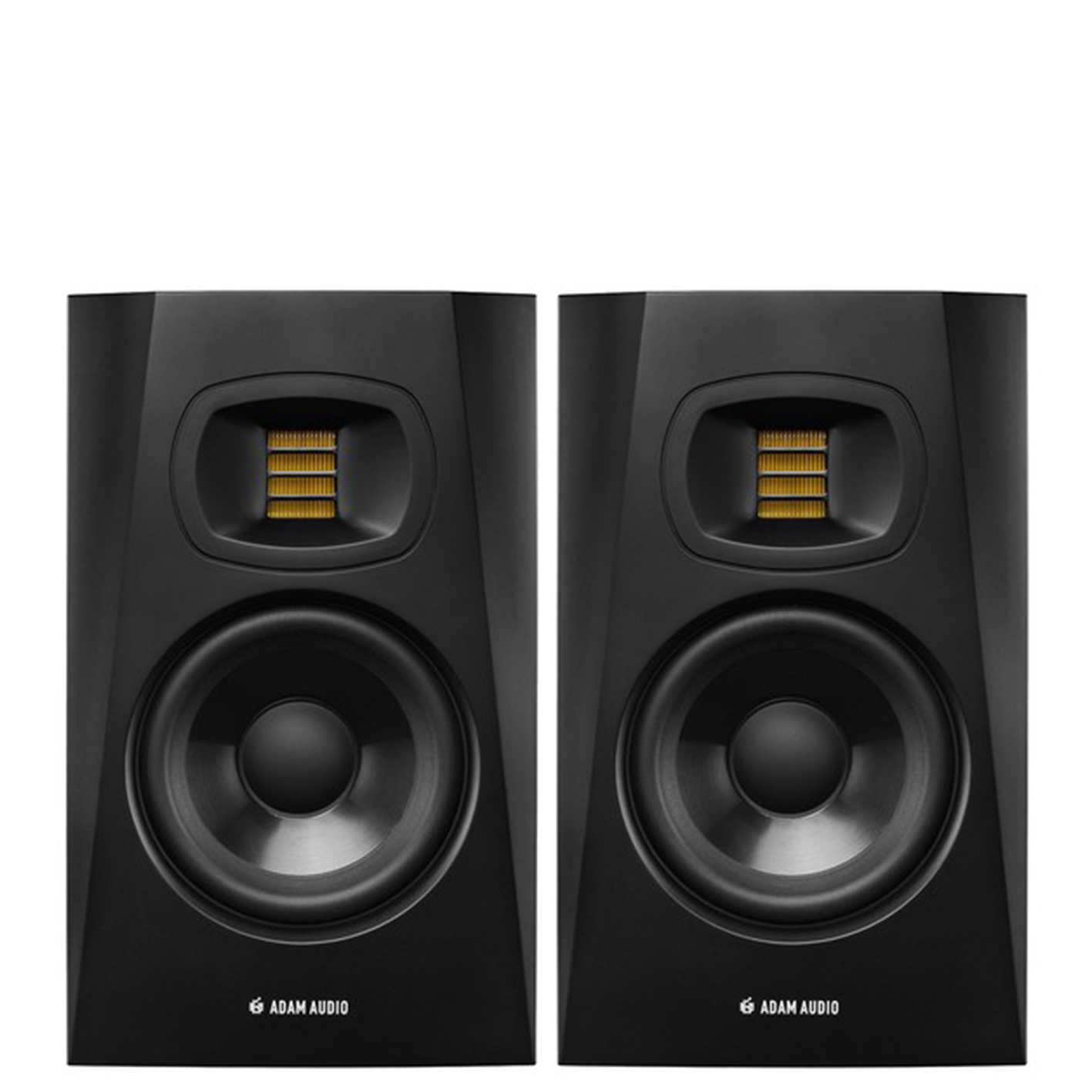
Adam Audio is well known for its high end monitors, but with the T5V the company is attempting to bring that know-how and quality into a cheaper design - and is largely succeeding. The speakers each feature a 5-inch woofer and Adam’s U-ART tweeter. It's a Class-D two-way design with a rear-ring bass reflex to cut down distortion in the low end.
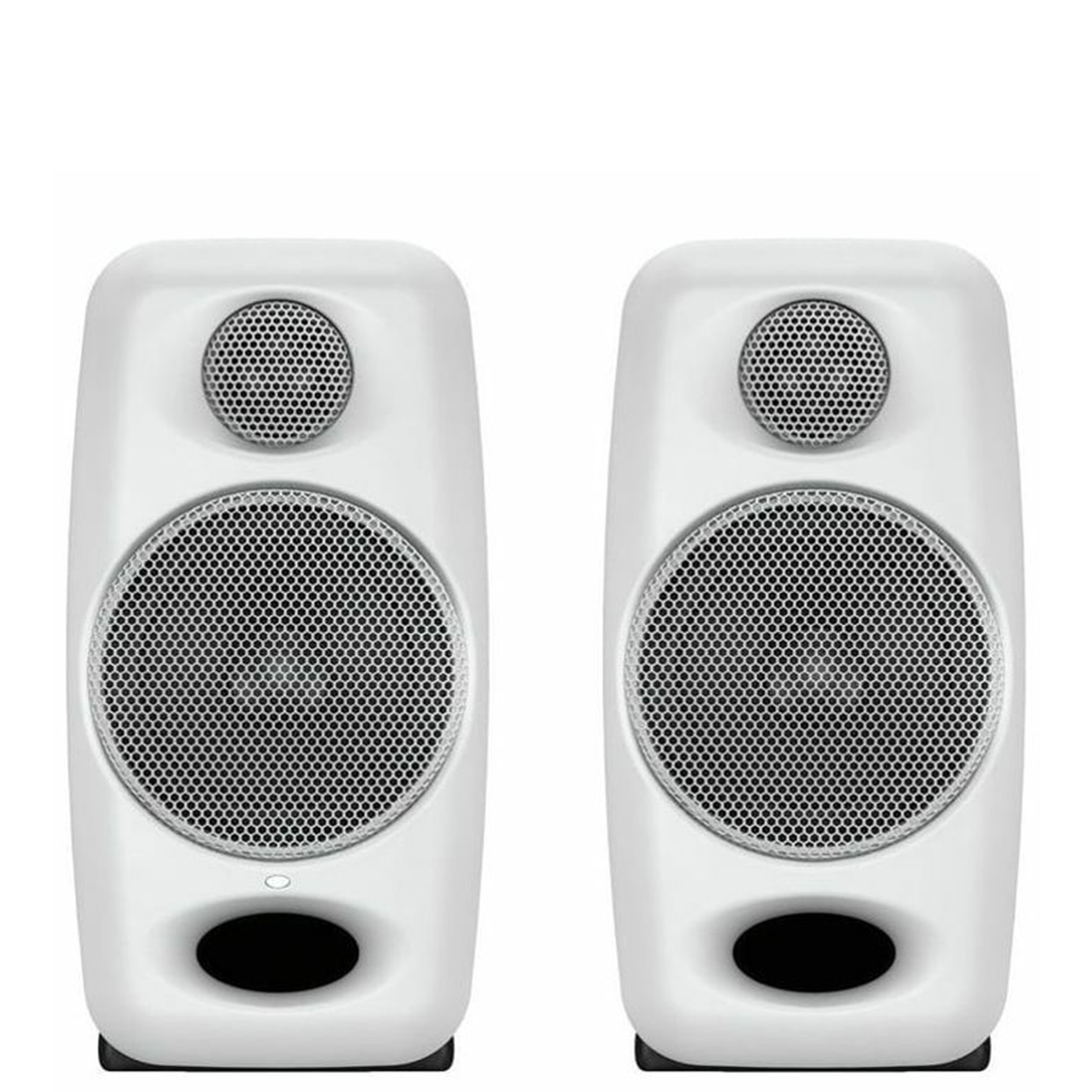
These studio monitors prove that you really can get a clear, accurate sound from a small 3” driver. Not only that, but the iLoud Micros also come with the kind of room-correcting EQ features which helps make them sound good wherever you place them. You won't find the same audio quality anywhere else for the money.
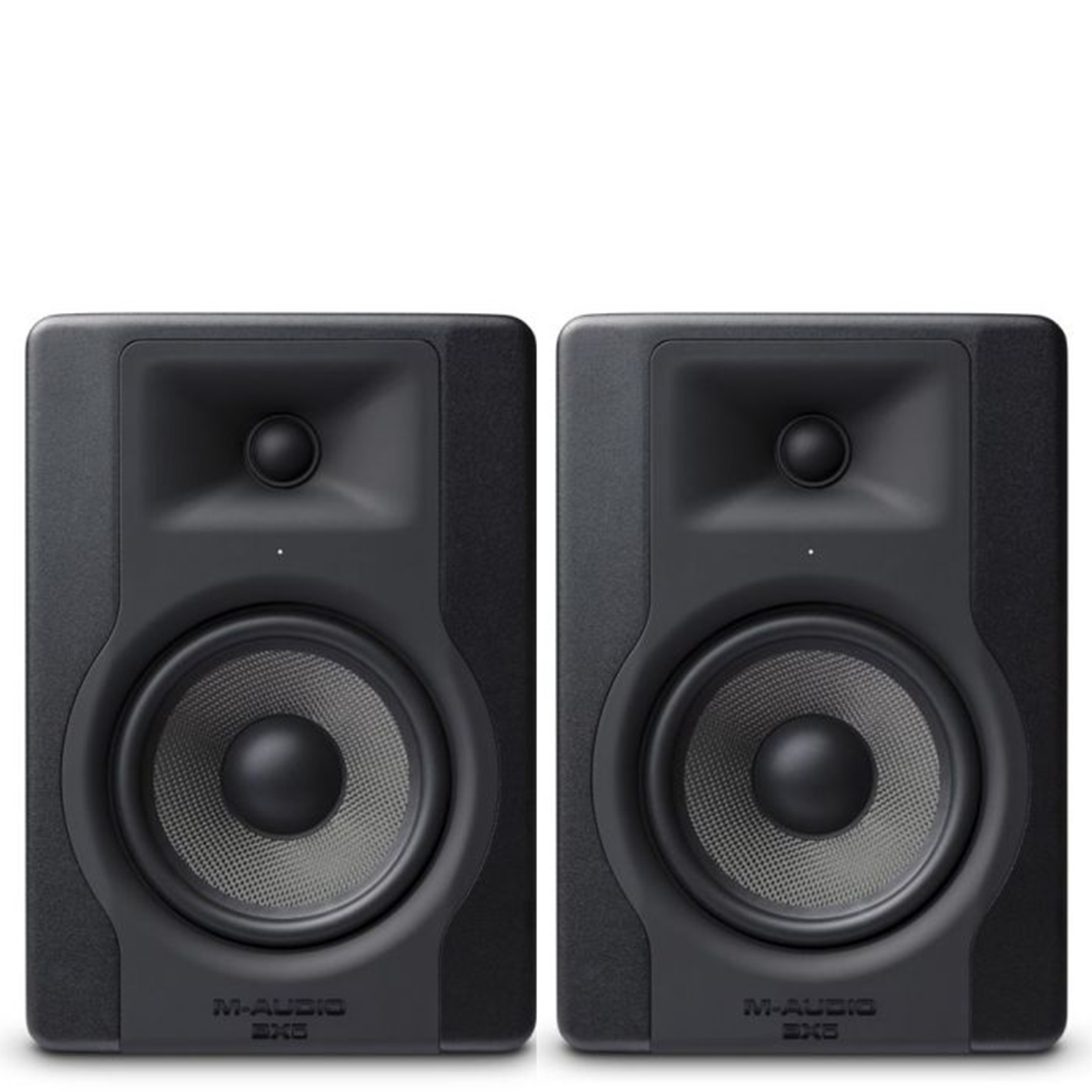
M-Audio has been designing well spec'd and great value monitors for quite some years now, and we’re big fans of the company's BX5 D3 series. That's because, unlike the kinds of speakers that also do podcasting and music playback, the BX5s are designed for quality reference studio monitoring, and that alone.
Load the next 3 products...
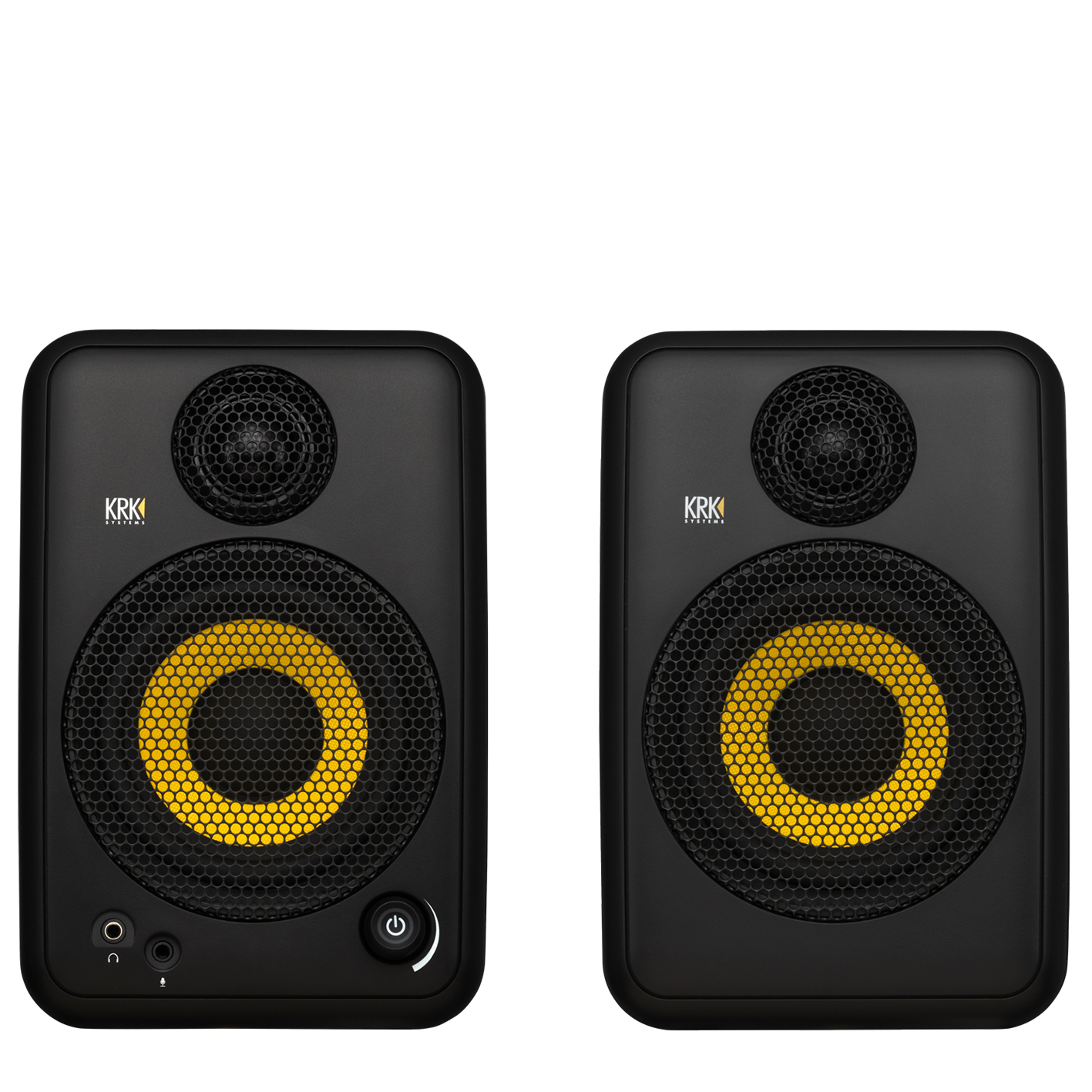
Each kit comprises a pair of monitors in a padded travel case with space for all the extras – it's a great package to take from studio to studio should you wish. The speakers also feature adjustable stands, Bluetooth capability, EQ (HF and LF), headphone output and front-mounted standby switch/level control.
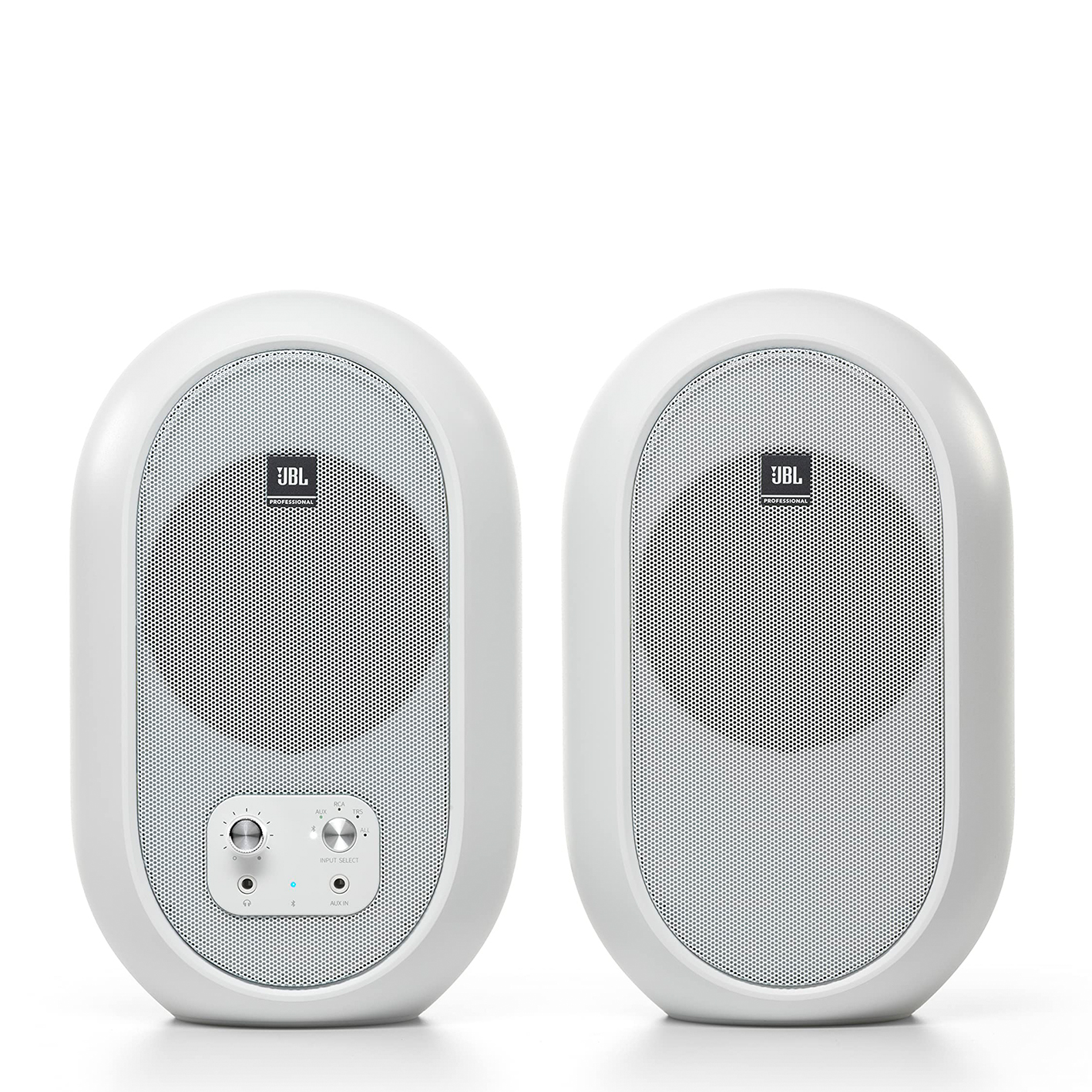
Designed with home recording, podcasting and portability in mind, these also deliver performance for not a lot of cash - these are among the cheapest speakers on test here. Despite the price though, we were seriously impressed with the sound - both tight and accurate across a good frequency range.
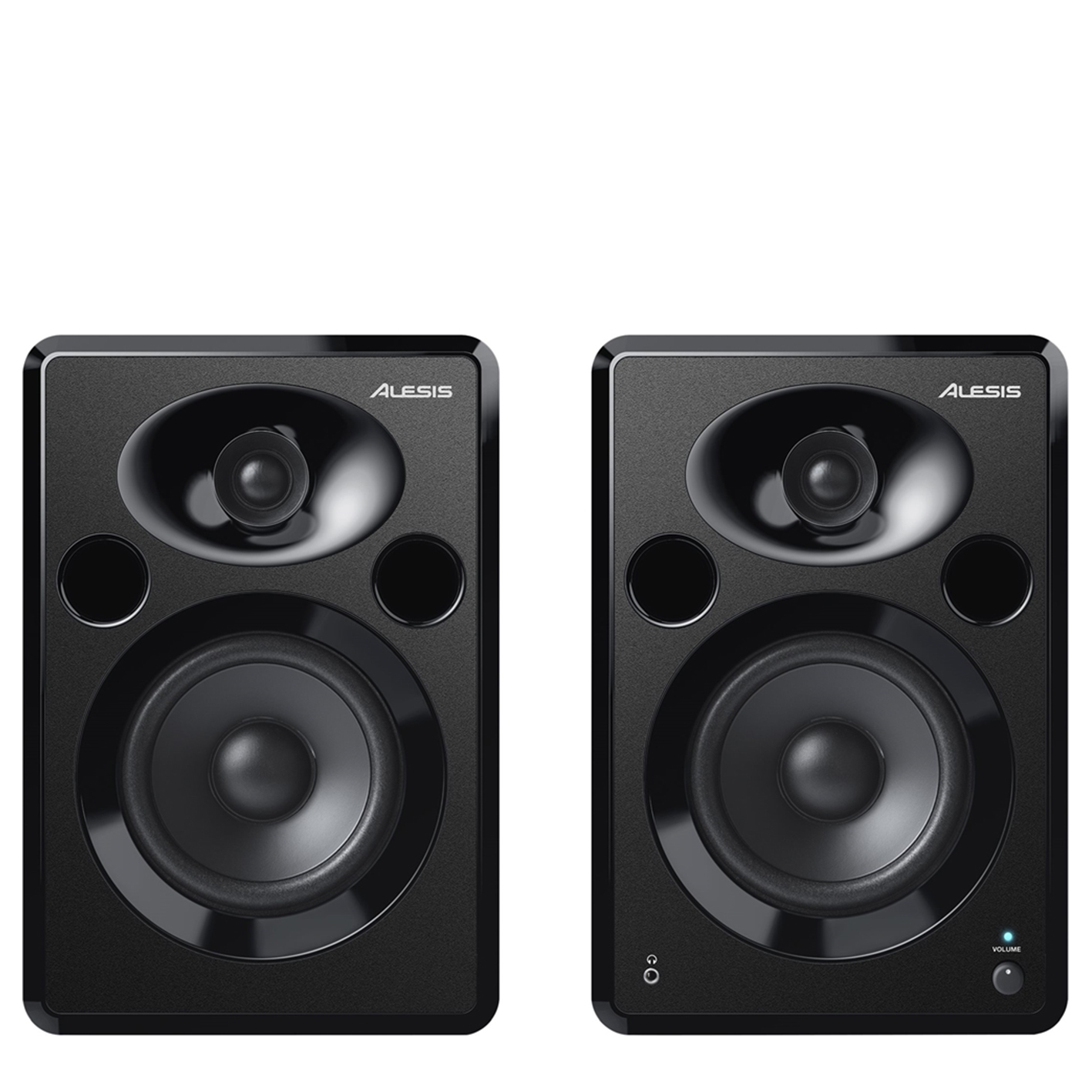
The Alesis Elevate 5 MKII might have a smaller frequency range than other speakers here, but that doesn’t have to be a deal breaker as Alesis has included a bass boost switch for those moments when you just want a good sound. However these speakers are good enough for the typical bedroom producer mixing in a more confined area.
Best studio monitors under $500/£500 available today
MusicRadar's got your back
Below you'll find full and detailed write-ups for each of the best studio monitors under $500/£500 in our list. We've tested each one extensively, so you can be sure that our recommendations can be trusted.
Best for bass heavy genres
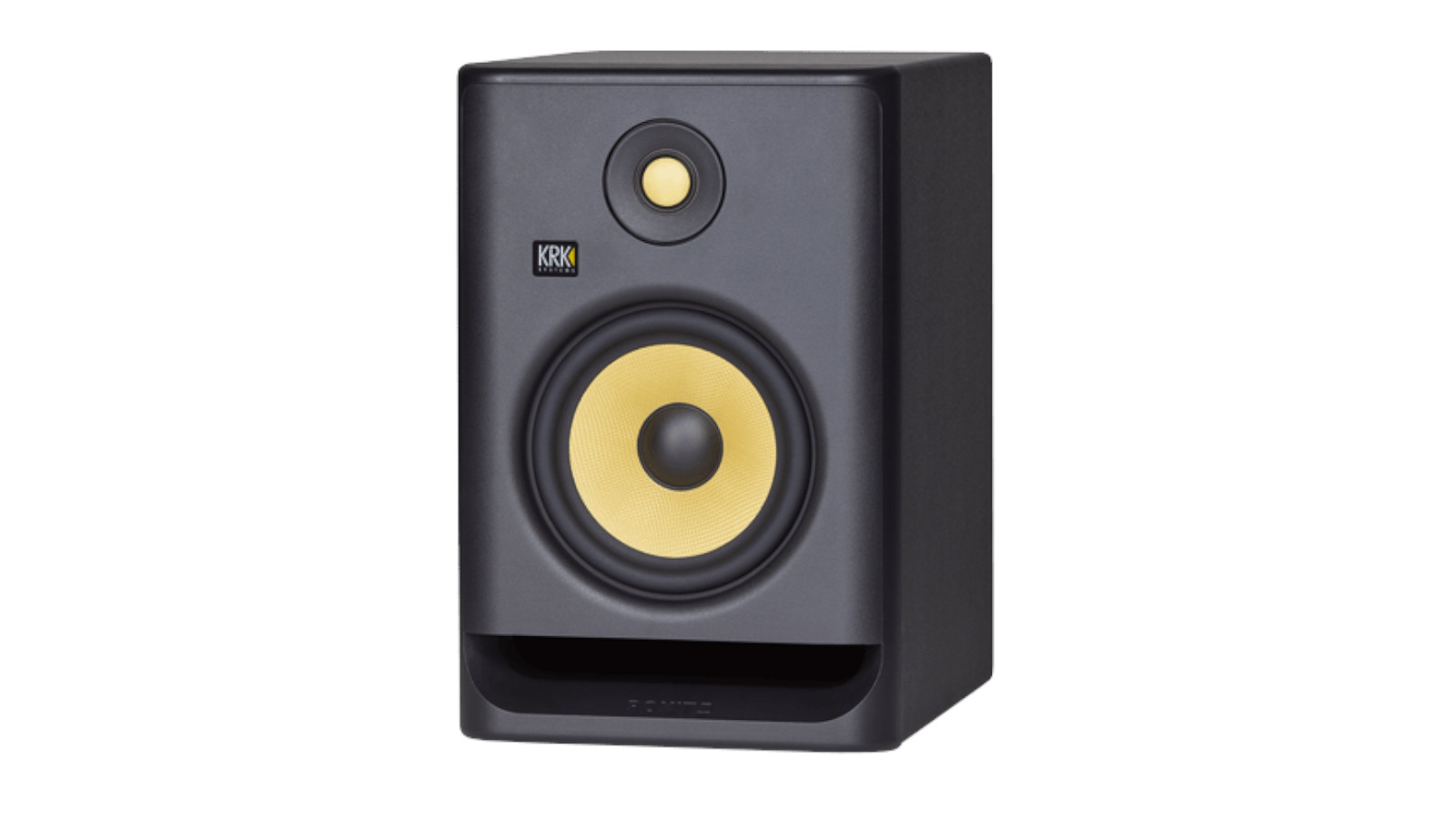
Specifications
Reasons to buy
Reasons to avoid
KRK speakers have become famous for both their distinctive yellow design and their use in contemporary electronic music genres. The Rokit series of KRK studio monitors is now in its fourth generation - hence the 'G4' in the title - and is the Gibson-owned brand's affordable nearfield speaker range.
The G4 range has some rare features for this price, the most notable being its extensive graphic EQ power. There's built-in digital signal processing (DSP) which offers a suite of tools that includes a room analyser. This has become more popular among higher-end speakers and essentially ensures the speakers' sound compensates for the space you're working in, taking account of any anomalies your room is causing over the frequency range. It works very well too and is very welcome at this price point.
On top of these extras, you get a solid build and decent specs with the RP7 G4s. And overall these KRK Rokits are some of the best budget studio monitors you can buy for smaller mixing spaces, and are especially suited for working in any bass-heavy genre.
Read the full KRK Rokit G4 review
Best for value
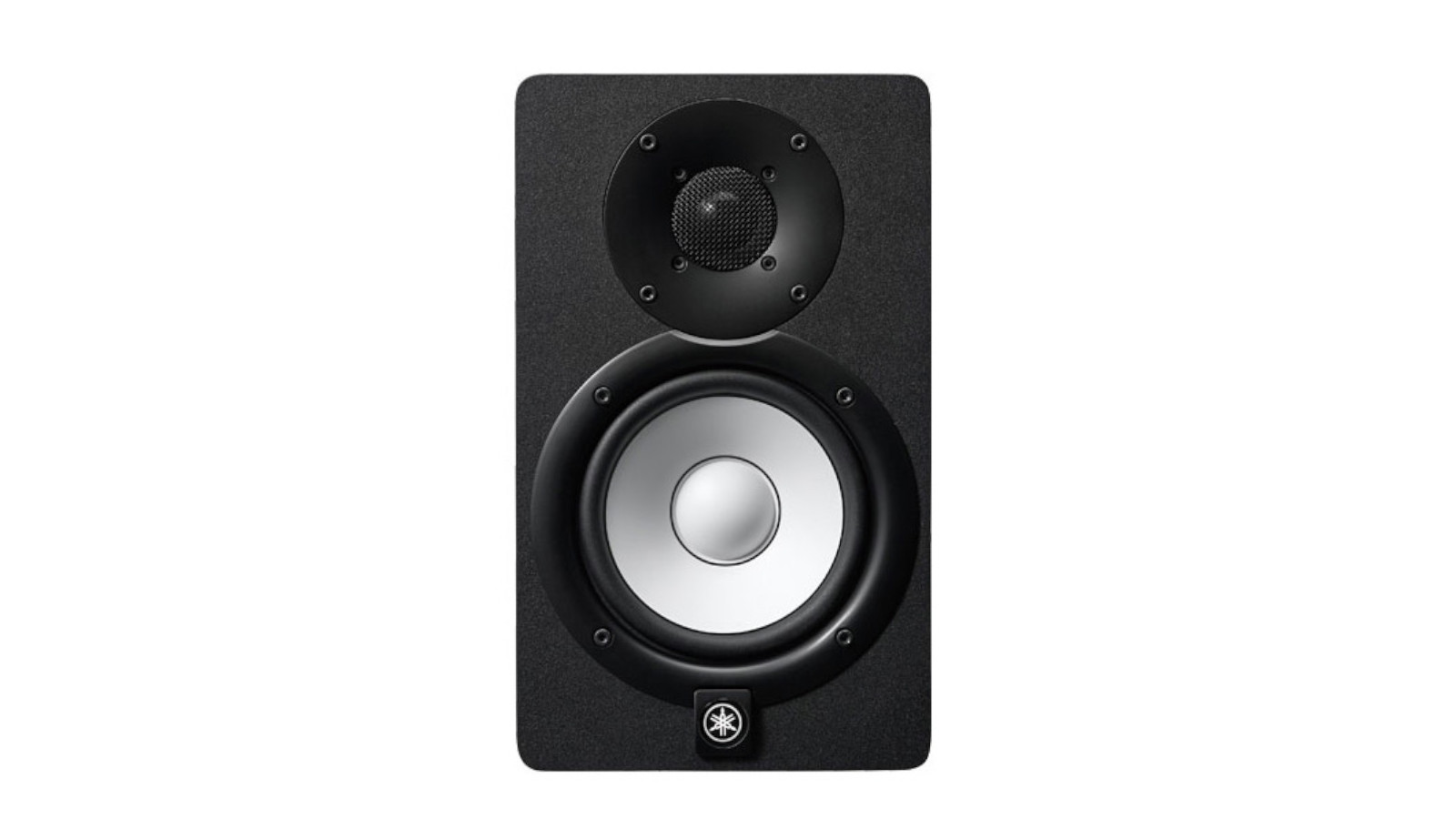
Specifications
Reasons to buy
Reasons to avoid
The HS5 monitors feature the distinctive white cones that make Yamaha monitors famous, but these are more compact than most. Measuring only 6.7" x 11.25" x 8.75" and weighing around 12 pounds, the HS5 are most obviously more suited to smaller studio set-ups. That said, a 45W amplifier powers the woofer, while a 25W amp drives the tweeter, so that's enough juice to make a pair of these go loud enough in most rooms.
The HS5s are incredible for their price. The imaging, transient response, high-frequency detail and depth are all superb. But the highlights of this monitor are its tight upper-bass and open low-midrange reproduction, giving a great overall sonic picture.
The Yamaha HS5 series are reference speakers which are built solely with mixing and monitoring in mind, so have no extras like Bluetooth or a graphic EQ, and room correction is basic. For sheer accuracy, however, they're hard to beat at this price and they are great for a wide range of mixing tasks.
Read the full Yamaha HS5 review
Best for larger studios
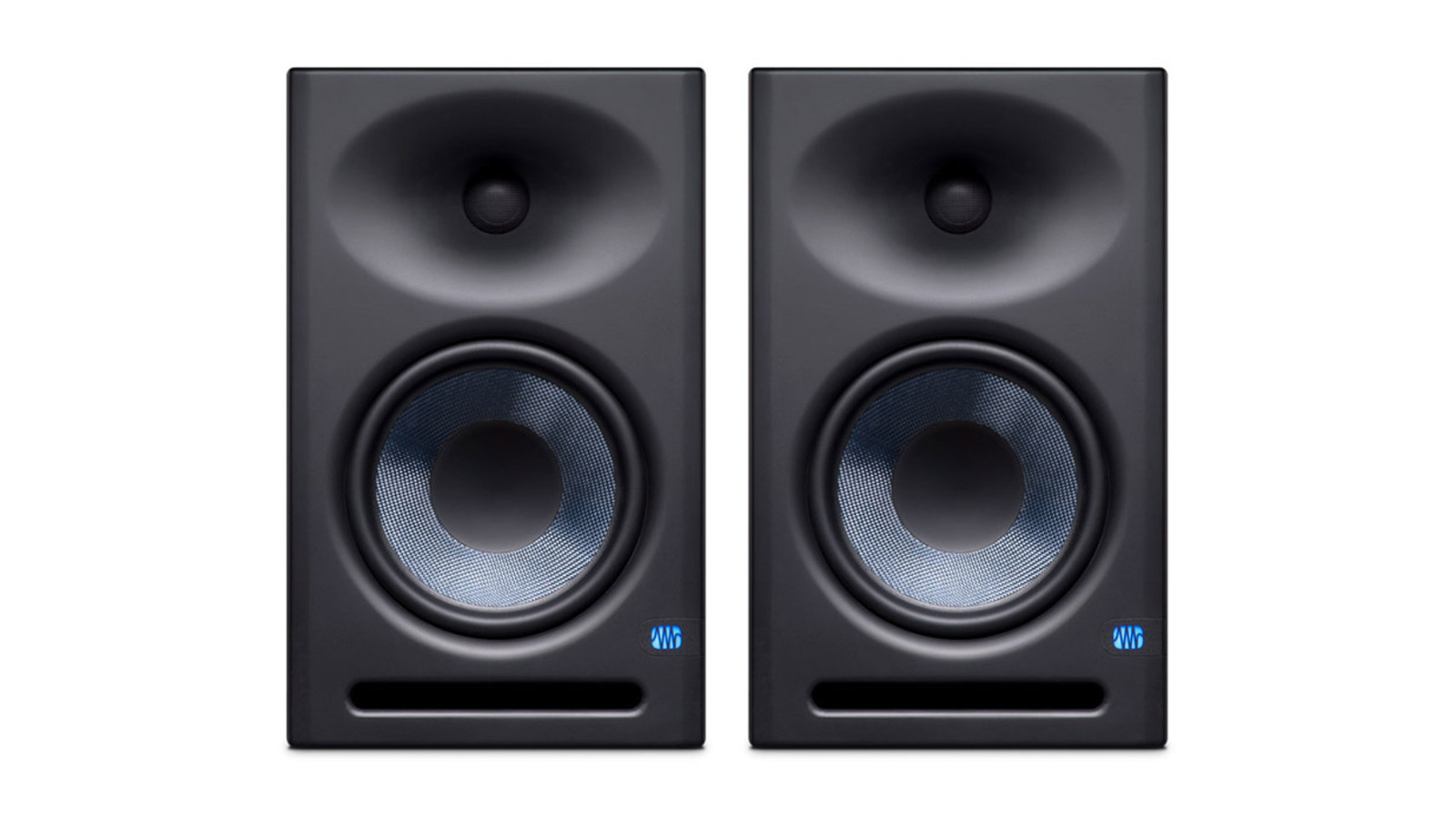
Specifications
Reasons to buy
Reasons to avoid
Eris is Presonus's most traditional speaker range and the E8XT is one of the larger monitors to feature in this guide. This latest model features an EBM tweeter waveguide and elliptical boundary-modelled design. These help deliver both a wide horizontal and narrow vertical dispersion. The horizontal width is very obvious when working with the speakers, and the sweet spot is easy to find and mix within. This is good news with larger monitors like these as you will be further away from them while working, and a wide sweet spot also means more people can listen in during playback and mixing.
The E8XTs feature controls around the back including gain, mid-peak and high-shelf EQs, low-cut filter, and a room correction option which curtails frequencies below 800Hz and helps when the monitors are in corners or up close to walls. It's a little basic compared to the room correction features found on models elsewhere in this guide, but handy nonetheless.
These extra EQ controls might not be required anyway, as the balance of the E8XT's sound is good and we didn’t initially feel the need to use any EQ. However, the mids can be a bit restrained on occasion so a boost from the mid-EQ (1kHz) might be necessary.
The E8XT delivers the sort of sound and volume you'd expect from slightly larger speakers. And coupled with the broad sweet spot and extended bass, they’re great for both tracking and mixing in larger spaces. Build quality is excellent and they also offer incredible value.
Read the full Presonus Eris E8XT review
Best for small studios
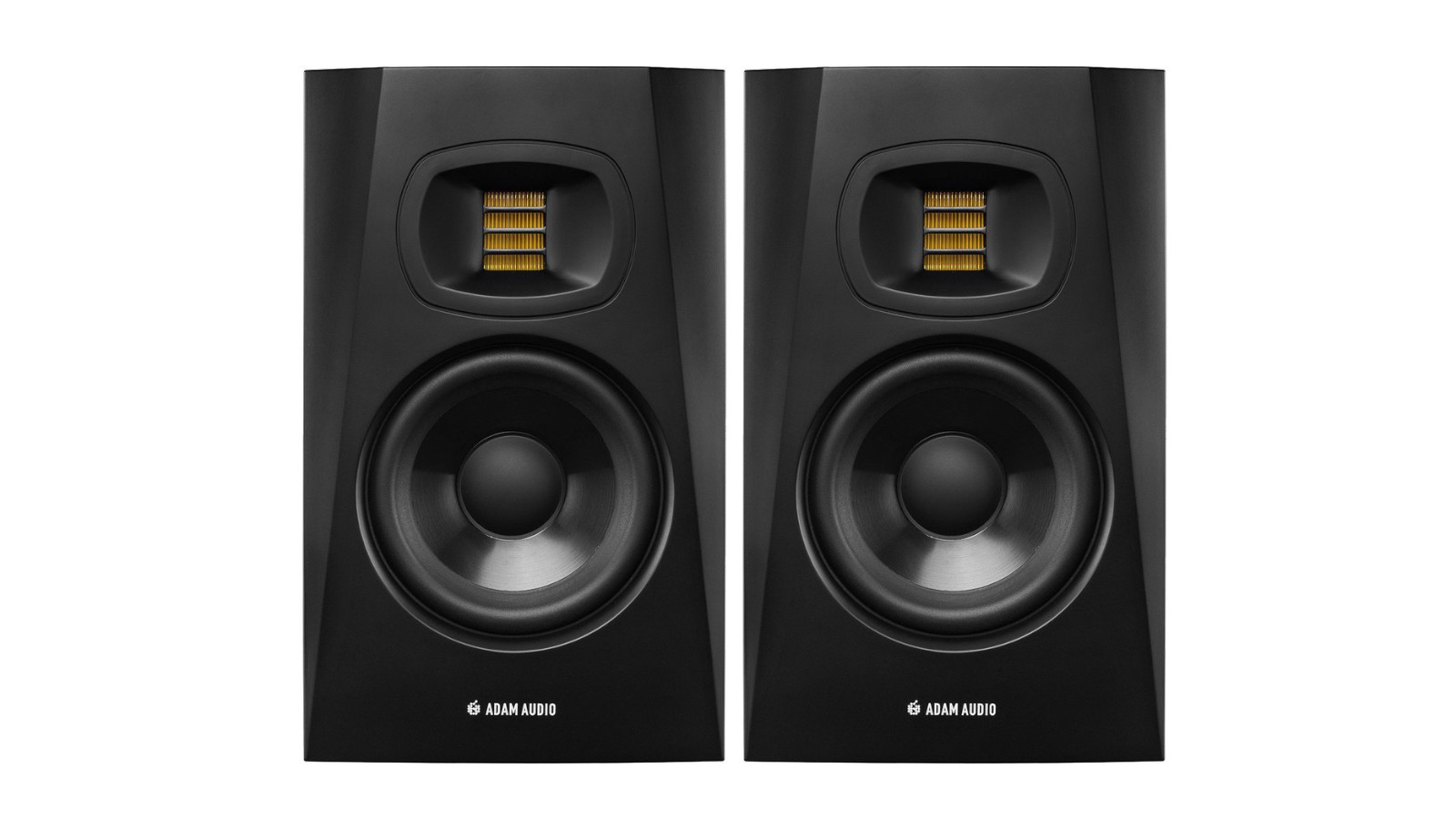
Specifications
Reasons to buy
Reasons to avoid
Adam Audio is well known for its high quality and high end studio monitors, and with the T5V, the company is attempting to bring that know-how and quality into a cheaper design - and is largely succeeding. The speakers each feature a 5-inch woofer and Adam’s U-ART (Unique Accelerated Ribbon Tweeter) tweeter. It's a Class-D two-way design with a rear-ring bass reflex to cut down distortion in the low end.
The top-end of the sound is very tight too, and an HPS waveguide helps produce a broad horizontal sweet spot. This is great if there are more than one of you mixing in the studio as you will both be able to enjoy the imaging and separation, both of which are also excellent.
While the monitors have both tight top and bottom end responses, the low midrange frequencies feel like they could be crisper, but we achieved this fairly easily by setting the LF EQ to -2dB.
Overall, then, the T5V is at a great price for an Adam Audio monitor that still delivers the quality you expect from the name.
Read the full Adam Audio T5V review
Best sound for the money
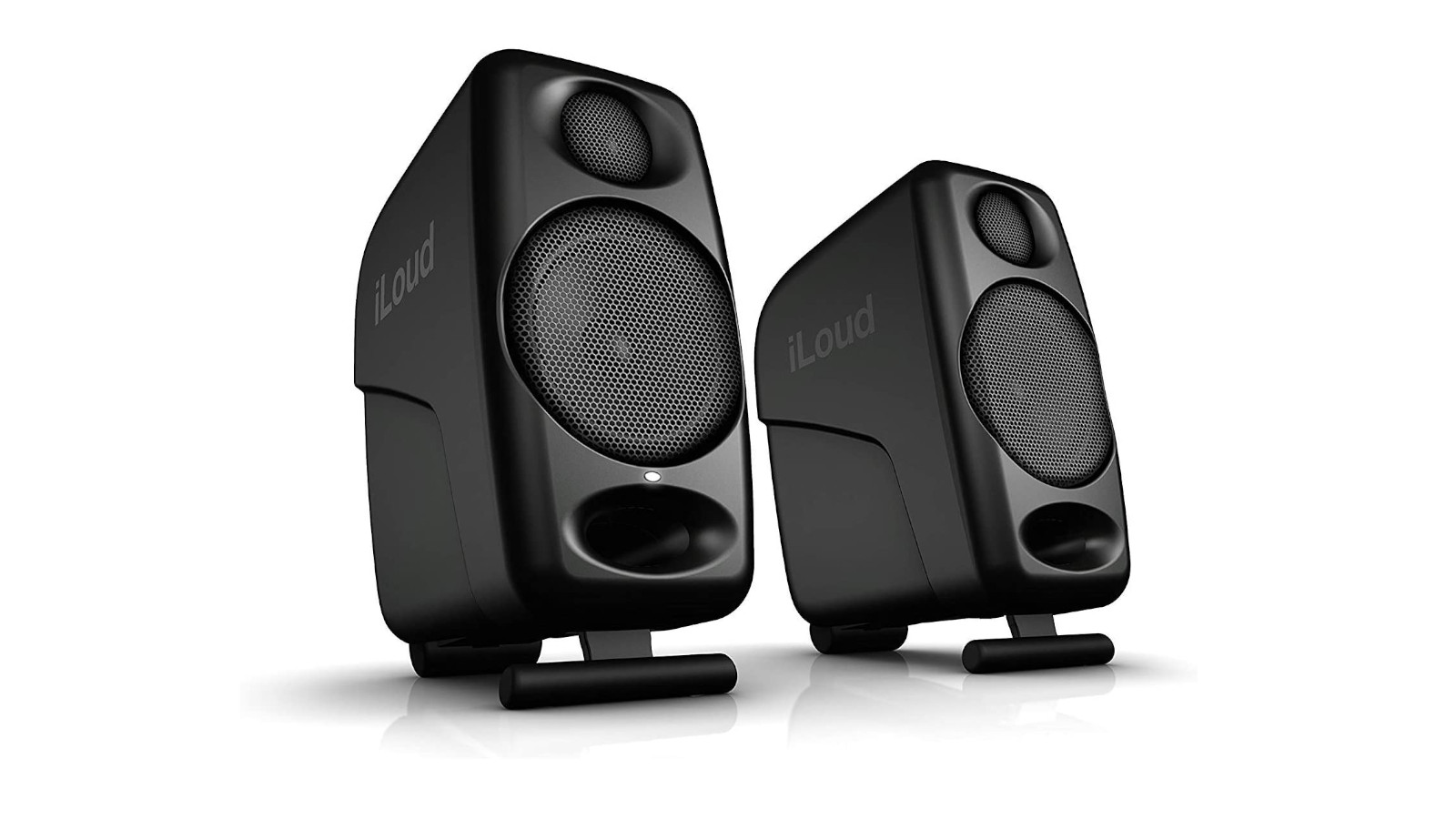
Specifications
Reasons to buy
Reasons to avoid
When the iLoud Micro monitors were released a few years back, no one could quite believe what IK Multimedia was trying to do by releasing a monitor so small. But these monitors prove that you really can get a clear, accurate sound from a small 3” driver. Not only that, the iLoud Micros also come with the kind of room-correcting EQ features which helps make them sound good wherever you place them.
You get a 1/8” jack input which makes them ideal for iPad or laptop producers, while the RCA inputs mean they can also cope with other inputs from record players, DJ mixers or audio interfaces.
The Bluetooth inclusion is handy - although we still prefer wired monitors for mixing. And judged just on this kind of monitoring performance, the iLoud Micros are still well worth considering as a serious studio monitor, especially if space is an issue in your studio or on your desktop.
Read the full IK Multimedia iLoud Micro review
Best for tight budgets
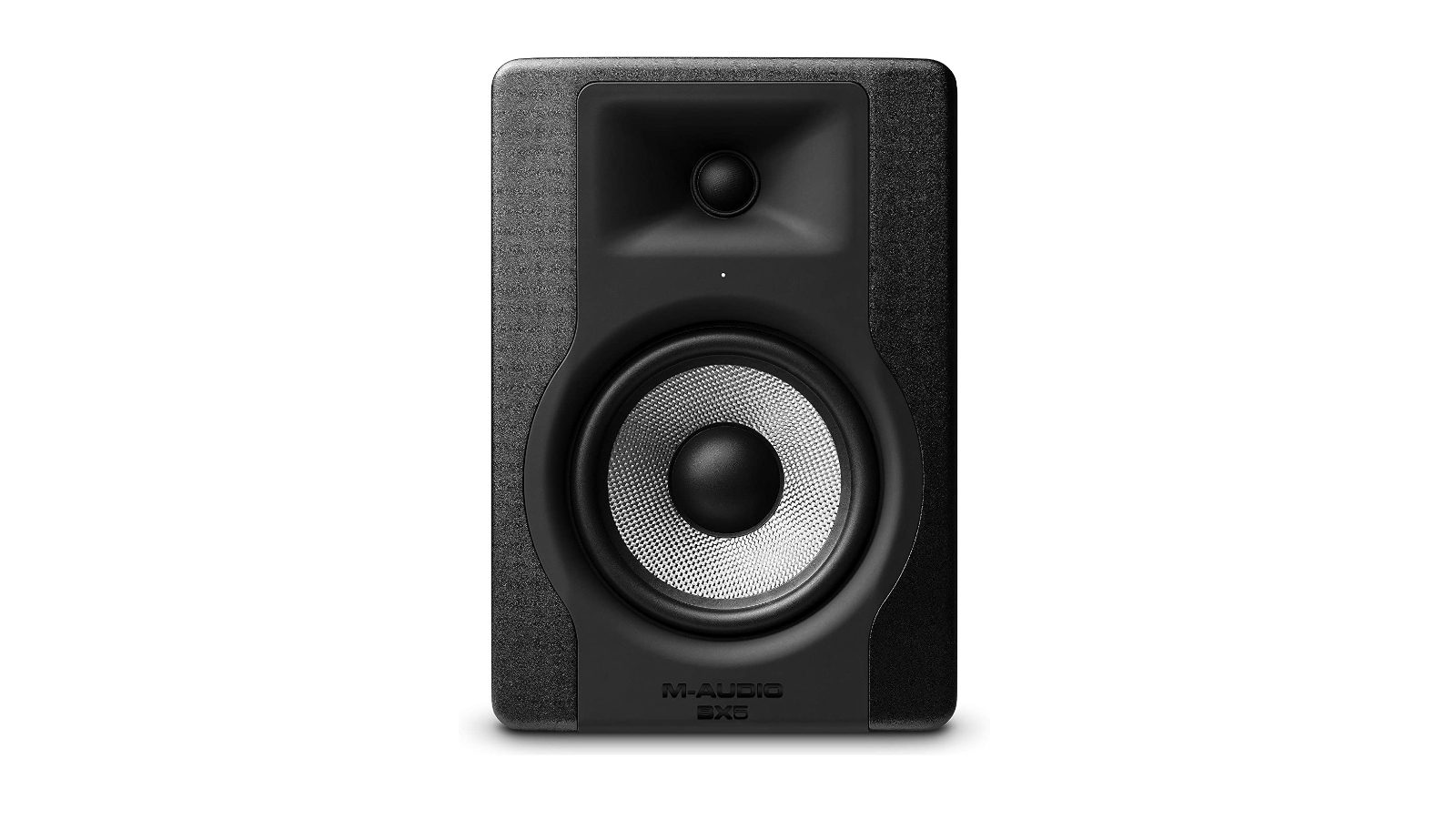
Specifications
Reasons to buy
Reasons to avoid
M-Audio has been designing well spec'd and great value monitors for quite some years now, and we’re big fans of the company's BX5 D3 series. That's because, unlike the kinds of speakers that also do podcasting and music playback, the BX5s are designed for quality reference studio monitoring, and that alone.
That wide frequency range - for the price you pay, anyway - is evident on listening to them. There are also other great extras such as room correction, and even a built-in LED light to that helps you have them set up at the right angle for listening.
The BX5 D3 is a great monitor choice if you are on a budget. It delivers clarity and accuracy, and all from a set of speakers that costs barely more than a set of headphones.
Read the full M-Audio BX5-D3 review
Best portable speakers
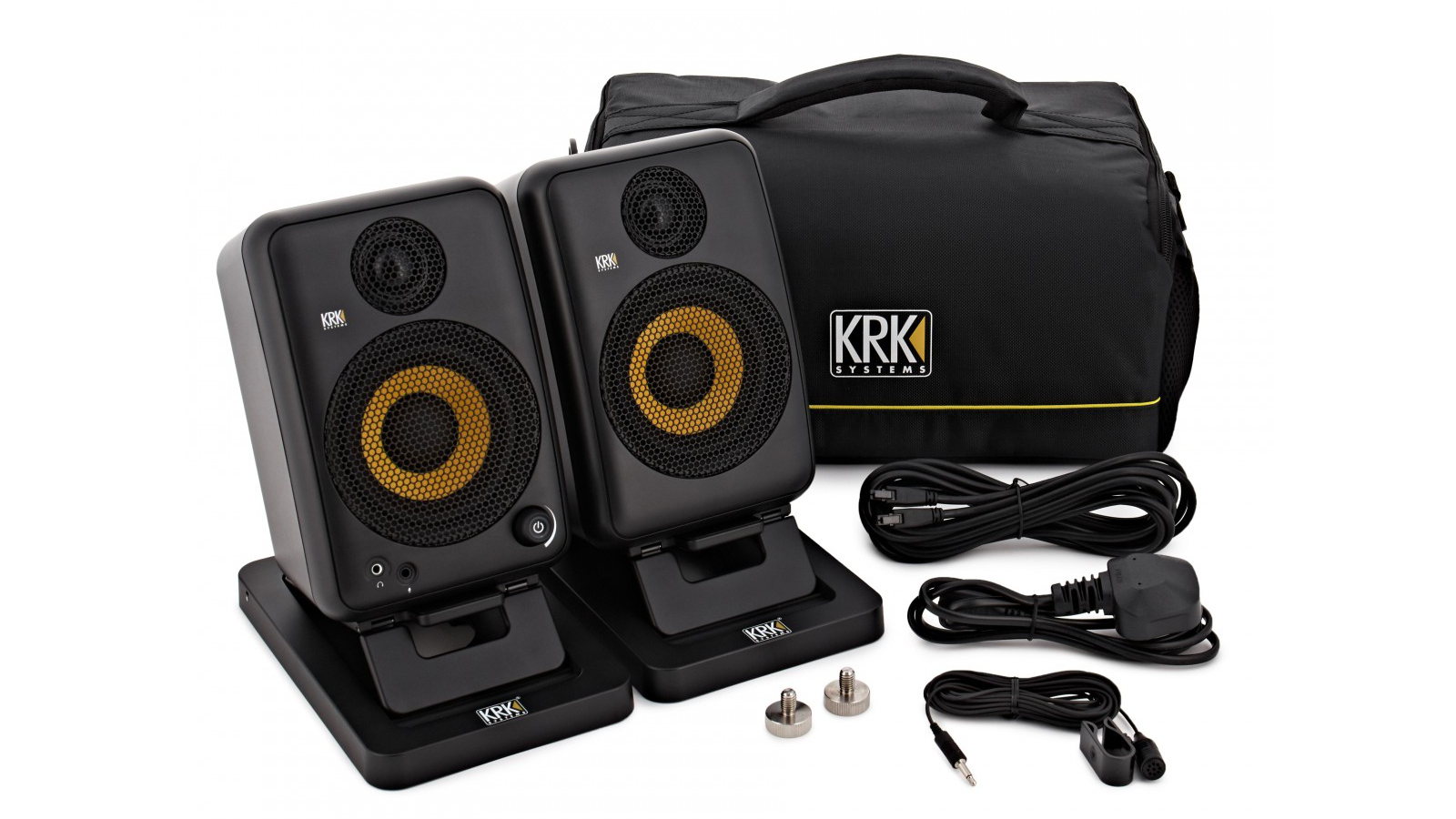
Specifications
Reasons to buy
Reasons to avoid
IK Multimedia has already shown us in this guide that fantastic small speakers are attainable. With the GoAux 3 and GoAux 4, KRK are doing the same and going even more mobile. Each kit comprises a pair of monitors in a padded travel case with space for all the extras – it's a great package to take from studio to studio should you wish.
The speakers also feature adjustable stands, Bluetooth capability, EQ (HF and LF), headphone output and front-mounted standby switch/level control. The left loudspeaker has all of this connectivity, and the other monitor is a remote unit linked via a lead.
With GoAux 4 you also get automatic room correction (ARC) which is a very handy feature at this price. It made a sonic difference for us, too - noticeable but not dramatic, the outcome made sense, knowing our studio as we do.
These are both great speaker packages for a good price. We'd probably opt for the 4, just for the extras, but either is a good buy.
Read the full KRK GoAux 3 and 4 review
Best compact monitors
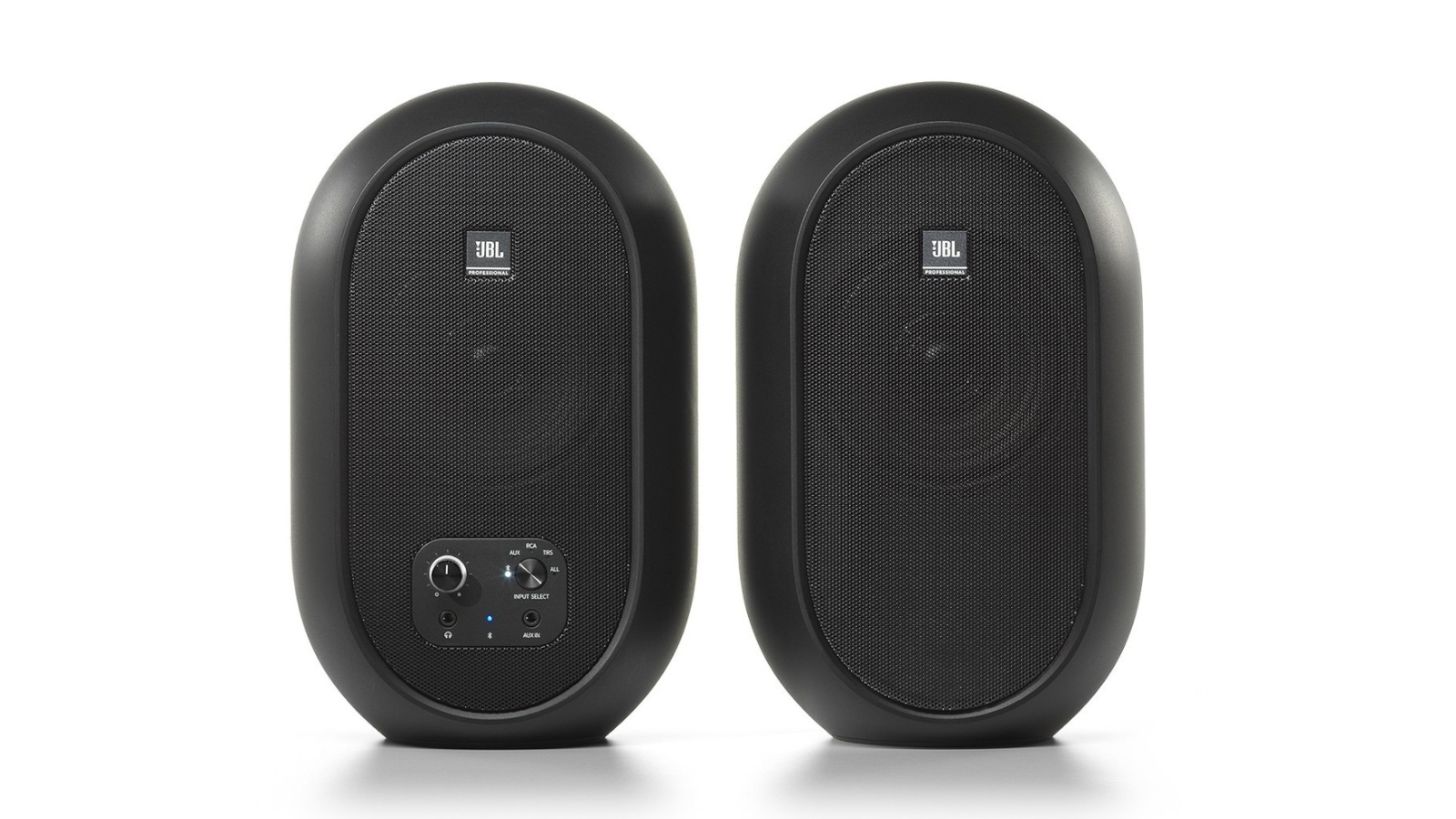
Specifications
Reasons to buy
Reasons to avoid
JBL's One Series 104 has been around for a few years now and is yet another speaker that delivers a great sound from a small monitor enclosure. Designed with home recording, podcasting and portability in mind, it also delivers that performance for not a lot of cash - these are among the cheapest speakers on test here. Despite the price though, we were seriously impressed with the sound - both tight and accurate across a good frequency range.
Bluetooth 5 connectivity via the BT version makes them versatile too - one minute they’re at the heart of your studio and the next they can be in the kitchen streaming from your phone. A great choice for lots of situations.
Read the full JBL One Series 104 review
Best all-round performance
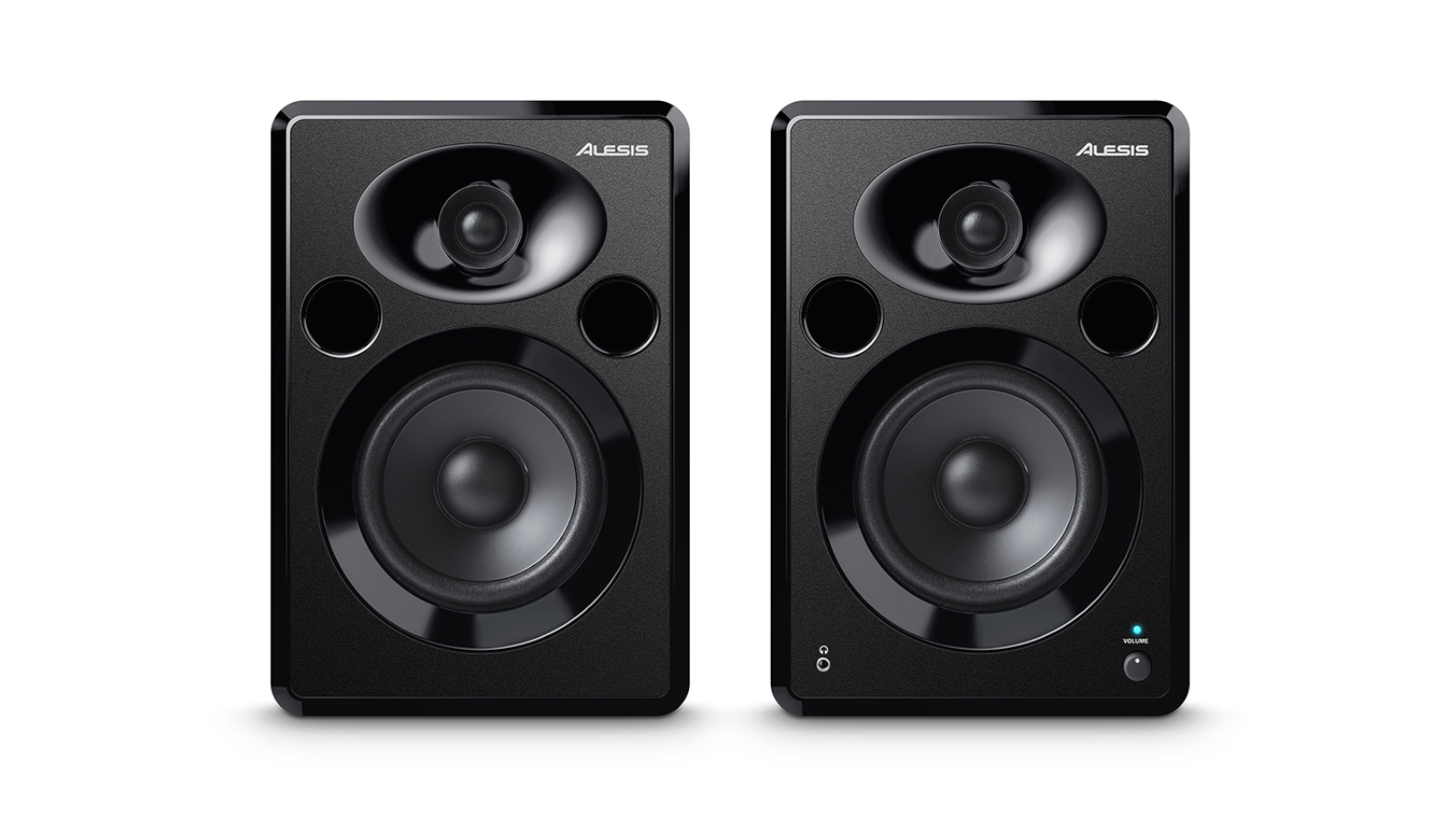
Specifications
Reasons to buy
Reasons to avoid
The Alesis Elevate 5 MKII might have a smaller frequency range than other speakers here, but that doesn’t have to be a deal breaker as Alesis has included a bass boost switch for those moments when you just want a good sound (but aren't mixing so much for accuracy).
When we tested these with reference listening in mind, we found that the 40 watts that the 5" driver and 1" high-frequency tweeter kicked out were fine for mixing in a smaller room, but you will need more power if you are mixing in a larger space.
However these speakers are good enough for the typical bedroom producer mixing in a more confined area. And if you want to use them for gaming or general listening, they make a good all-round purchase.
Read the full Alesis Elevate 5 MKII review
Best studio monitors under $500/£500: Buying advice
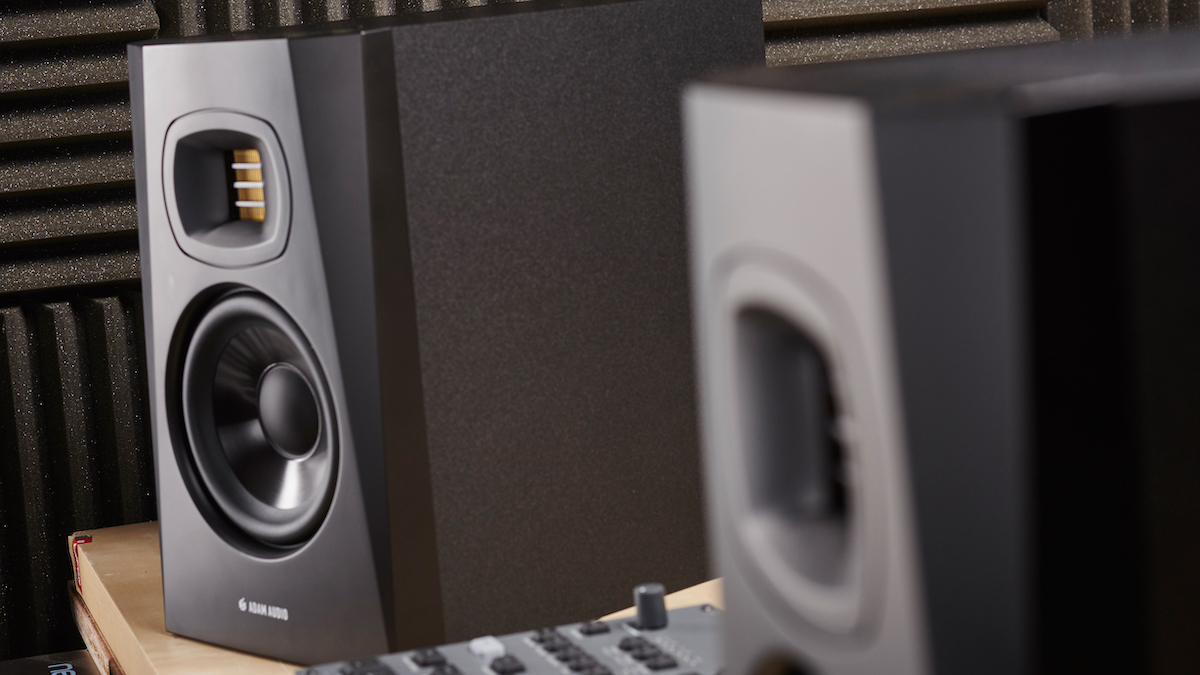
Do I need active or passive speakers?
Electrical signals from a home studio mixer or audio interface tend to be weak so monitors often need an amplifier built into them. These are known as active monitors but you can buy passive ones, where the amplifier is separate and external. Active monitors tend to be more balanced and a better choice as the amplifier and speaker systems are designed together - not always the case with separate amps and passive speakers.
What size studio monitors do I need?
As a general rule - although not always the case - the bigger the monitor, the bigger the volume and bolder the bass. Your room’s size and how well it is acoustically treated will also determine the size of monitor it can handle. Big and bold monitors can overload a small space; similarly small speakers can get lost in a larger studio.
Where should I place monitors in my room?
You tend to listen to monitors in an equilateral triangle set-up, where your distance from each speaker is the same as the distance between them. Nearfield monitors are designed to be placed fairly close to the listener’s ears in a typical home studio so are also closer together. Midfield monitors, on the other hand, should be placed further away, at a further distance apart, in a bigger room.
Monitor sizes are based around the diameter of the woofer diameter - usually from three inches to eight inches. For most small to medium rooms, nearfields are more than adequate.
How do I connect my monitors to my computer or interface?
Active monitors usually have jack, XLR, phono, digital or USB connections on them that can hook straight up to an audio interface. Use the balanced connections on both to reduce noise and interference.
With passive monitors, the separate amplifier discussed above will be required between interface and speakers - another reason they can complicate a set-up. Active monitors also have a level control and some of the room-compensating EQ features that we have covered in the reviews above.
How we test the best studio monitors under $500/£500
Studio monitors should tell you everything about your music in as honest a way as possible, and they do this by having a flat frequency response. This means it is not coloured or enhanced in any way, which is often the case in consumer level speakers which might have their basses boosted – for example – to improve their overall sound.
Studio monitors aim for a flat frequency response because if they have a boosted bass – as in those consumer monitors we just mentioned – you would then reduce it while mixing and the results would be a thin mix when played on another system. Basically a flat frequency response is best because what you mix is what you get!
The wider this quoted frequency response, the better too. This means you'll hear all of the high and low frequencies in the mix. You'll typically get specs that deliver low frequencies down to 40-80Hz and upper ones at the edge of human hearing at 20kHz.
While the frequency range can be tested electronically, we also test studio monitors with reference music – our own trusted mixes of music that we know very well – where we can tell if any areas of the frequency spectrum have been enhanced or reduced. Hearing the pinpoint detail in a trusted mix is what we're really listening out for when testing studio monitors.
We also look out for speaker design elements like bass ports which reduce low end distortion, and the rigidity of the cabinets which can help deliver a tight transient – the attack part of the sound. This is evident in poorer speaker designs where a less rigid enclosure might result in flabbier sounding mixes.
We also test for the stereo width a set of monitors can deliver, as hearing a wide sound can let you accurately place instruments in a mix so they don't clash. Finally, we're also listening out for the 'sweet spot', the ideal listening position to enjoy the best sound from the speakers. Some of the better studio speakers feature a wider sweet spot which means you are not restricted in where you sit when mixing and also makes them great for bigger studios where more than one person can mix at the same time.
Read more about how we test music making gear and services at MusicRadar.
Related buyer's guides
- Best studio headphones: expert picks for music production and mixing
- Best budget studio headphones: top cheap cans for every studio task
- Best MIDI keyboards for beginners: entry level keyboards
- Best studio monitor stands: optimise your home studio
Want all the hottest music and gear news, reviews, deals, features and more, direct to your inbox? Sign up here.
Andy has been writing about music production and technology for 30 years having started out on Music Technology magazine back in 1992. He has edited the magazines Future Music, Keyboard Review, MusicTech and Computer Music, which he helped launch back in 1998. He owns way too many synthesizers.